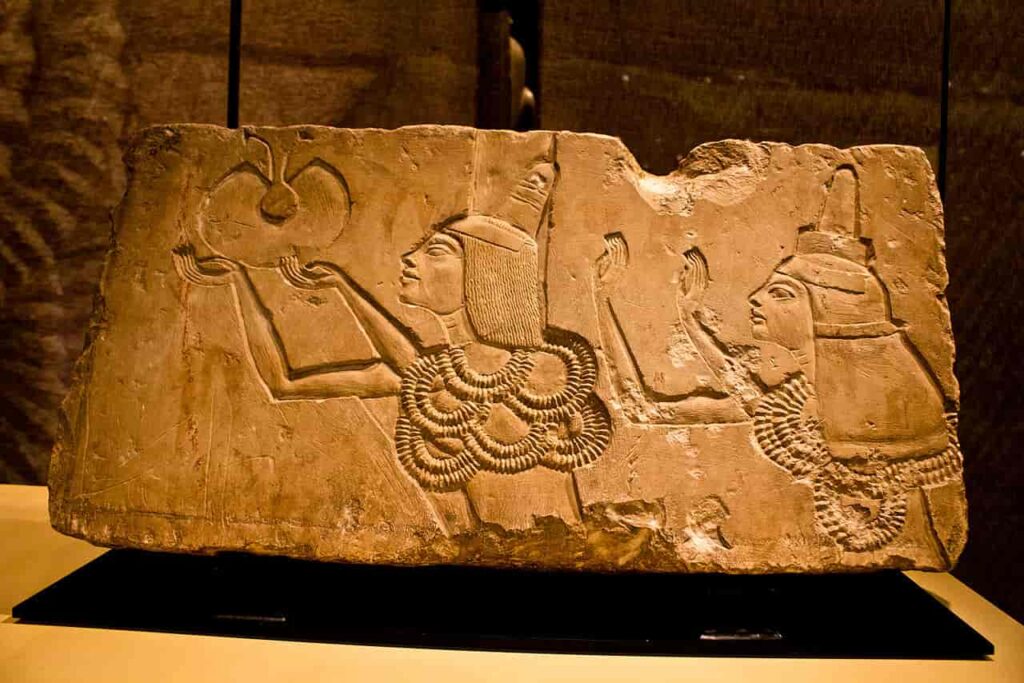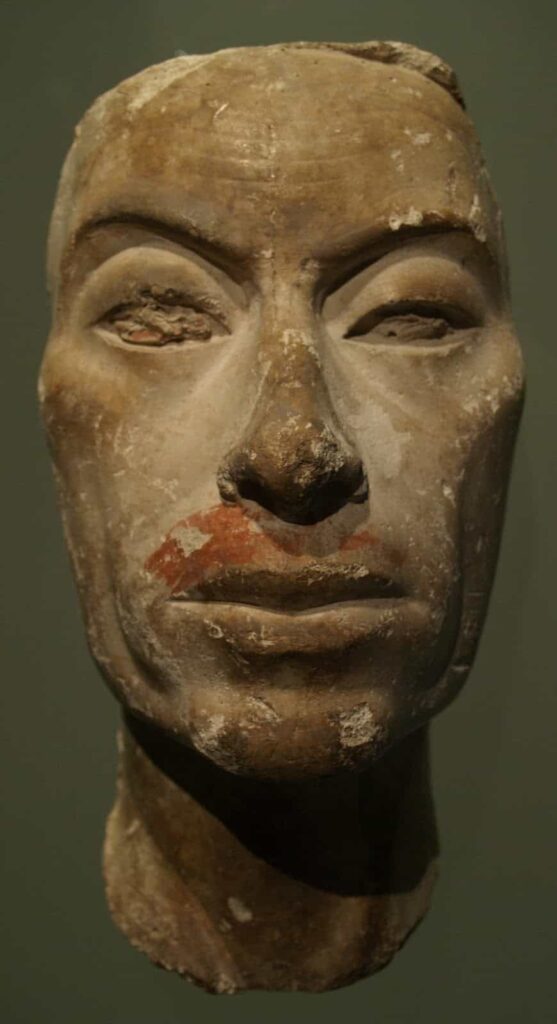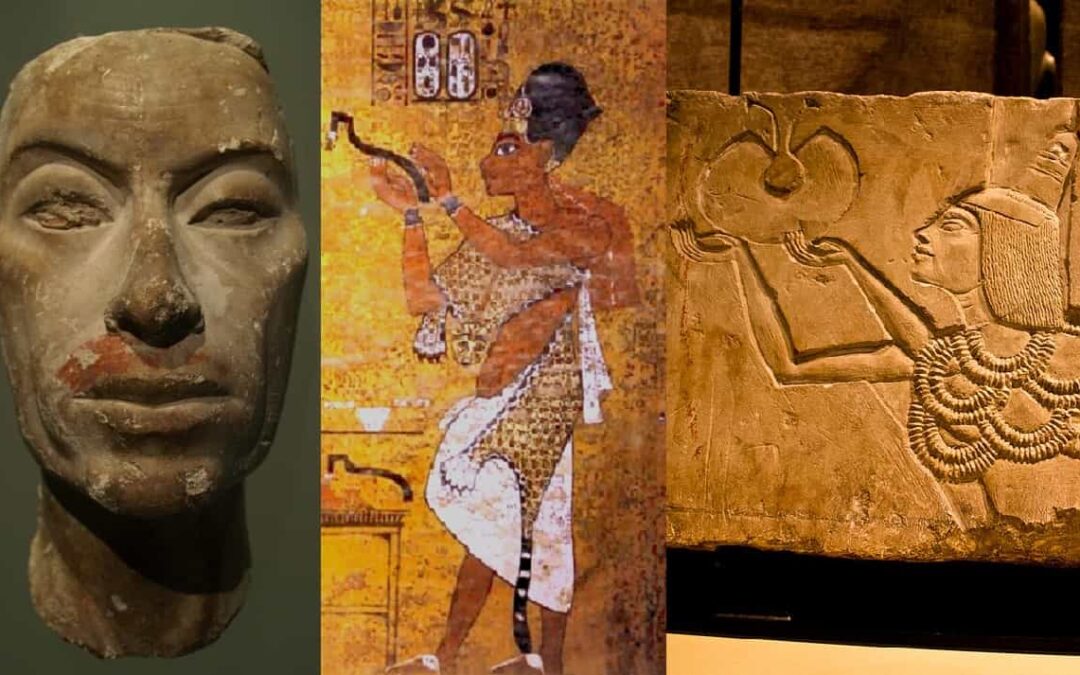Ay was the penultimate Pharaoh of the 18th dynasty of ancient Egypt. He ruled from c. 1327/5 to 1323/1 BC, and his coronation name was “Kheperkheperure, ‘Eternal are the Manifestations of Ra, the Doer of Justice’.”
Family Relations
There are various theories about the origin of Ay, but there is not enough evidence to support any of them conclusively. Some suggest a family relationship with Queen Tiye and her parents Yuya and Thuya, but there is no solid proof of this. It is known that Ay was from the city of Akhmim, like Tiye’s parents.
Ay is recognized as the progenitor of Queen Nefertiti, the Great Royal Wife of Pharaoh Akhenaten and considered the “Giver of Heirs.” This means that the royal succession had to go through a son or daughter of Nefertiti.
Therefore, Ay is considered the grandfather of the princesses that Pharaoh Akhenaten had with Nefertiti: Meritaten, Meketaten, Ankhesenpaaten, Neferneferuaten-Tasherit, Neferneferure, and Setepenre.
At the end of the reign of Pharaoh Tutankhamun, Ay ascended to the throne and married the widowed queen, his granddaughter Ankhesenpaaten (later called Ankhesenamun). This was not considered a sexual union, but rather a political arrangement to legitimize Ay’s claim to the throne.
Ay had another famous daughter who became queen later on: Mutnedjmet, who was the daughter of Ay and his second wife Tey.
Biography of Ay
The beginnings of Ay date back to the reign of Pharaoh Amenhotep III, who was a high dignitary during his long reign. It is thought that the wedding between his daughter Nefertiti and the young prince Amenhotep (later Amenhotep IV) occurred late in Amenhotep III’s reign.
Akhenaten’s appointment as co-regent with his father resulted in Nefertiti’s elevation to co-regent’s wife, which undoubtedly elevated Ay to the highest levels of the court.
Ay was likely part of the courtier entourage who accompanied Pharaoh Amenhotep III during the celebration of his Heb-Sed festivals in his palace in Malkata near Thebes.
During Pharaoh Akhenaten’s reign, Ay was named “God’s Father,” a title indicating his close family relationship with the pharaoh.
In his high position, Ay witnessed the rise of Pharaoh Amenhotep IV (Akhenaten), the implementation of the Aten religion, the regime’s radicalization, the abandonment of Thebes, the inauguration of Akhetaten, the reception of foreign ambassadors and vassals in Akhenaten’s 12th year, the death of Queen Mother Tiye, Nefertiti, and several of his granddaughters.
He also saw the rise of the co-regent Smenkhkare, the death of Akhenaten and Smenkhkare, the enthronement of the young prince Tutankhamun, and his premature and unexpected death. In short, Ay was a key witness to the entire Amarna Period.
The reign of Ay
The reign of Ay began with the intensification of the return to religious orthodoxy following the ascension of the young Pharaoh Tutankhamun. The process of restoring traditional religious practices involved not only moving the capital of the country back to Thebes from Akhetaten, but also relocating the necropolis and official dependencies.
Given the young age of the Pharaoh, it is believed that the government was managed by two high officials from the Amarna period, Horemheb and Ay.
The sudden and unexpected death of Tutankhamun led to speculation of a brief interregnum, but some Egyptologists dispute this theory due to evidence from the murals in Tutankhamun’s tomb showing Ay performing the rite of “Opening the Mouth” to the pharaoh’s mummy. This evidence suggests that Ay was the designated successor, making an interregnum unlikely.
Ay’s ascent to the throne was due to his close relationship to the royal family and the absence of Horemheb during a military campaign. He married his own granddaughter, the widow Ankhesenamun, to demonstrate continuity with the reigning dynasty and legitimize his position as Pharaoh.
Ay’s reign was dedicated to repairing the damage caused by the Amarna period in all aspects of the state, including restoring the hierarchy of the state bureaucracy and rebuilding temples of previously outlawed gods.
However, given Ay’s advanced age, his reign was brief. He was succeeded by Horemheb, who married Ay and Tey’s daughter, Mutnedjmet, to legitimize his ascension and prevent Ay’s son Nakhtmin from becoming a contender for the throne.
Horemheb ruled with an iron hand and ordered the erasure of all previous reigns that caused the Amarna crisis, including Akhenaten, Smenkhkare, Tutankhamun, and Ay.
Ay was buried in the Valley of the Monkeys, near the tomb of his brother-in-law Amenhotep III. The tomb, known as WV23, was modest in size compared to other royal tombs and is believed to have been usurped by Ay from Tutankhamun. Ay’s mummy has yet to be found.









